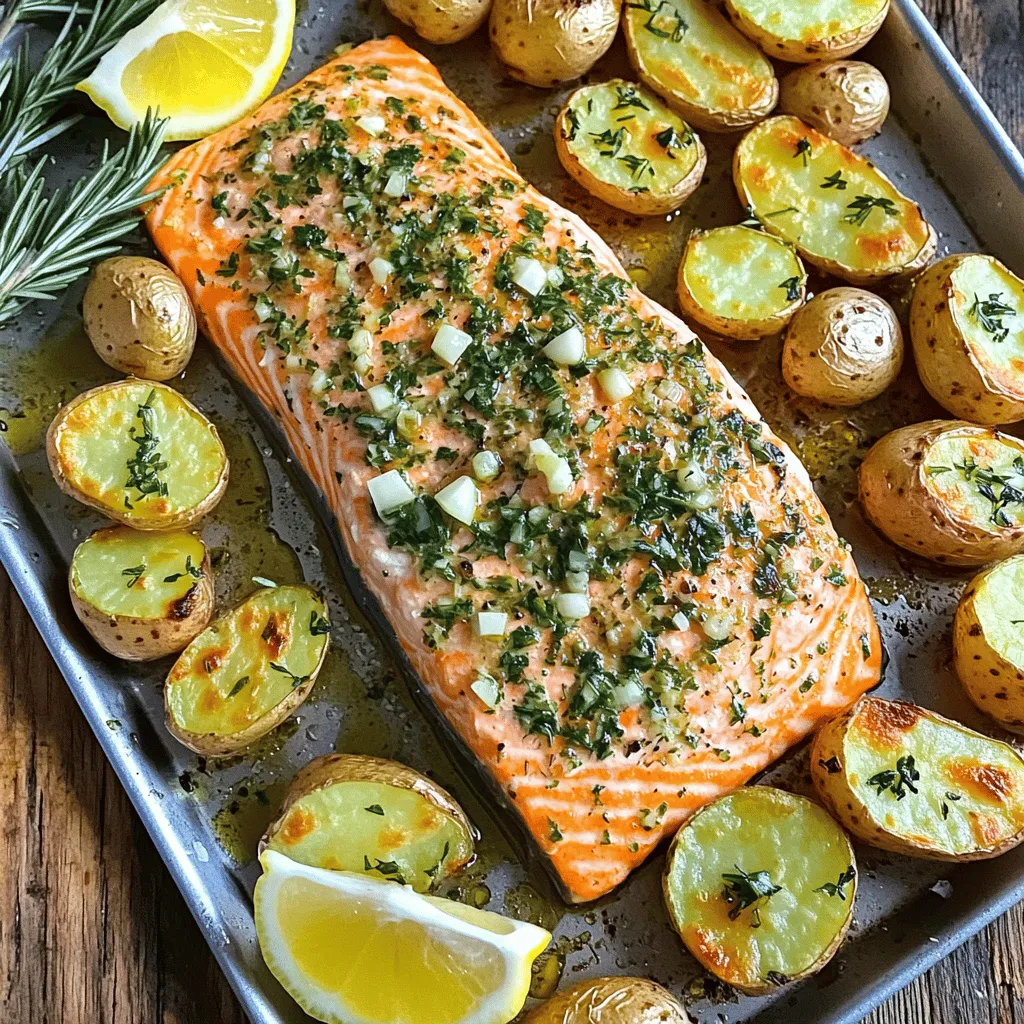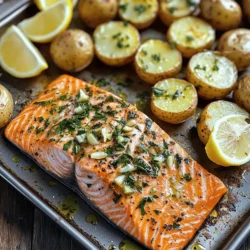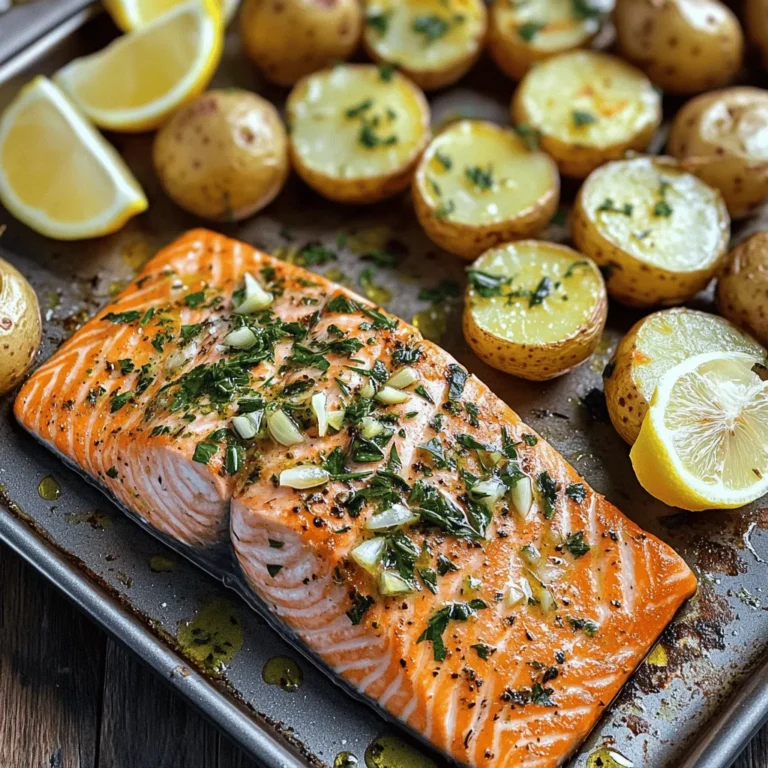Looking for a tasty, easy meal? My Savory Sheet Pan Garlic Herb Salmon & Potatoes dish is perfect! With just a few simple ingredients, you get a flavorful dinner that is ready in no time. Salmon fillets, baby potatoes, and fresh herbs come together for a mouthwatering meal. Let’s dive into the tips and steps that make this dish a family favorite!
Ingredients
Main Ingredients
– 4 salmon fillets
– 1 pound baby potatoes, halved
– 4 cloves garlic, minced
– 2 tablespoons olive oil
Fresh Herbs and Seasonings
– 1 tablespoon fresh rosemary, chopped
– 1 tablespoon fresh parsley, chopped
– Zest and juice of 1 lemon
– Salt and black pepper to taste
Optional Serving Suggestions
– Lemon wedges
– Additional herbs for garnish
Using fresh ingredients makes a big difference in taste. The salmon fillets bring rich flavor and healthy fats. Baby potatoes add a hearty touch and soak up the garlic and herbs. Garlic gives a nice punch, and olive oil helps everything roast evenly.
Fresh herbs elevate this dish. Rosemary adds a warm, earthy taste, while parsley brings a pop of color and freshness. The lemon zest and juice brighten the flavors, making each bite refreshing. Salt and black pepper enhance everything, bringing it all together.
For serving, lemon wedges add extra zing. You can also use more fresh herbs for a lovely finish. This simple dish is packed with flavor and looks beautiful on the table. Enjoy the ease of cooking everything on one pan!
Step-by-Step Instructions
Preparing the Oven and Ingredients
– Preheat the oven to 400°F (200°C).
– In a large bowl, combine halved baby potatoes, garlic, olive oil, rosemary, lemon zest, salt, and pepper. Toss well to coat every potato piece.
Roasting the Potatoes
– Spread the seasoned potatoes in a single layer on a large sheet pan.
– Roast in the oven for 15 minutes. This helps them get golden and tender.
Preparing the Salmon
– While the potatoes roast, season the salmon fillets with remaining garlic, olive oil, lemon juice, parsley, salt, and pepper.
– Make sure each fillet is well-coated for great flavor.
Final Cooking Steps
– After 15 minutes, carefully take out the pan. Push the potatoes to one side.
– Place the seasoned salmon fillets on the other side of the pan.
– Return the pan to the oven. Roast for an additional 12-15 minutes.
– Check the salmon for doneness. It should flake easily with a fork. The potatoes should also be golden and soft.
Tips & Tricks
Perfecting the Salmon
To get the best salmon, avoid overcooking it. Salmon cooks fast, so watch it closely. When it’s done, the fish should flake easily with a fork. This means it is ready to eat. Use a fork to test the thickness of the fish. If it falls apart, it is perfect.
Flavor Enhancements
Add herbs and spices for a flavor boost. I love using dill or thyme with salmon. They pair well with the garlic and lemon. For a marinade, mix olive oil, lemon juice, and your favorite herbs. Let the salmon soak for 30 minutes for extra taste.
Cooking Time Adjustments
If your salmon fillets are thick, you may need more time. For thicker pieces, add 2-3 extra minutes to the cooking time. If you’re cooking for a larger group, use two sheet pans. This way, everything cooks evenly. Just make sure to rotate the pans halfway through.

Variations
Vegetable Add-ins
You can add many veggies to your sheet pan dish. Try carrots, bell peppers, or zucchini. These add color and flavor. Seasonal veggies work great, too. In spring, use asparagus or peas. In fall, consider butternut squash or Brussels sprouts. Mixing veggies gives you more taste and nutrition.
Different Cooking Methods
You can grill or bake your salmon and potatoes. Grilling gives a nice smoky flavor. It may take less time, so watch closely. Baking is easier for a complete meal, as it cooks everything evenly. A toaster oven works well, too, especially for smaller portions. Just adjust the time to fit your oven.
Sauces and Accompaniments
Pair your dish with sauces for extra flavor. Lemon butter sauce brightens the meal. A creamy dill sauce adds zest. For sides, serve a fresh salad or steamed green beans. They balance the rich salmon. You can also add rice or quinoa for a heartier meal. These options make your dish more exciting!
Storage Info
Refrigeration Guidelines
To store leftovers, place the salmon and potatoes in an airtight container. This helps keep them fresh. Make sure they cool down first. Refrigerate within two hours of cooking. It is best to eat leftovers within three days for the best flavor and texture.
To keep salmon fresh, wrap it tightly in plastic wrap or foil. You can also use a vacuum-sealed bag. This reduces air exposure and helps maintain moisture.
Reheating Suggestions
To reheat salmon and potatoes, the oven works best. Preheat it to 350°F (175°C). Place the salmon and potatoes on a baking sheet. Cover them with foil to keep moisture in. Heat for about 10 to 15 minutes, or until warmed through.
To avoid drying out, add a splash of water or broth to the pan before reheating. This will help steam the food and keep it juicy.
Freezing Tips
Yes, you can freeze leftovers. Wrap the salmon and potatoes tightly in freezer-safe bags or containers. Remove as much air as possible to prevent freezer burn.
For best results, freeze them within two days of cooking. When ready to eat, thaw in the fridge overnight. To reheat, follow the oven method mentioned earlier. This keeps the flavors intact and ensures a tasty meal.
FAQs
How long to cook salmon on a sheet pan?
You should cook salmon for about 12 to 15 minutes. This is after roasting the potatoes for 15 minutes. The salmon should be flaky and cooked through.
Can I use frozen salmon for this recipe?
Yes, you can use frozen salmon. Just thaw it first. It cooks best when it is at room temperature.
What’s the best way to know when salmon is done?
The best way is to check if it flakes easily with a fork. The inside should also be opaque. You can use a food thermometer. It should read 145°F (63°C).
How can I make this recipe low-carb?
To make this dish low-carb, skip the potatoes. You can use zucchini or cauliflower instead. These vegetables roast well and have fewer carbs.
Can I substitute other vegetables in this dish?
Yes, you can swap vegetables based on what you have. Bell peppers, asparagus, or broccoli work well. Just make sure to cut them into similar sizes for even cooking.
This blog post detailed how to create a simple and tasty salmon dish. We covered the main ingredients, like salmon, potatoes, and fresh herbs. You learned the steps to roast everything perfectly in the oven. With tips on flavor and cooking methods, this recipe is both flexible and easy.
In my view, cooking should be fun and rewarding. Enjoy trying new flavors and variations! Happy cooking!


